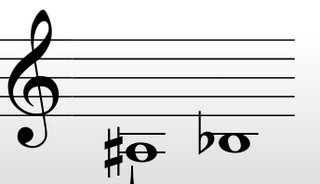In music, a glissando is a glide from one pitch to another. It is an Italianized musical term derived from the French glisser, "to glide". In some contexts, it is distinguished from the continuous portamento. Some colloquial equivalents are slide, sweep, bend, smear, rip, lip, plop, or falling hail. On wind instruments, a scoop is a glissando ascending to the onset of a note achieved entirely with the embouchure.
Staccato is a form of musical articulation. In modern notation, it signifies a note of shortened duration, separated from the note that may follow by silence. It has been described by theorists and has appeared in music since at least 1676.

The crumhorn is a double reed instrument of the woodwind family, most commonly used during the Renaissance period. In modern times, particularly since the 1960s, there has been a revival of interest in early music, and crumhorns are being played again. It was also spelled krummhorn, krumhorn, krum horn, and cremorne.
A multiphonic is an extended technique on a monophonic musical instrument in which several notes are produced at once. This includes wind, reed, and brass instruments, as well as the human voice. Multiphonic-like sounds on string instruments, both bowed and hammered, have also been called multiphonics, for lack of better terminology and scarcity of research.

The contrabass oboe is a double reed woodwind instrument in the key of C or F, sounding two octaves or an octave and a fifth (respectively) lower than the standard oboe.
The year 1648 in music involved some significant events.
The decade of the 1510s in music involved some significant events.
Portato, also mezzo-staccato, French notes portées, in music denotes a smooth, pulsing articulation and is often notated by adding dots under slur markings.
The 1360s in music involved some significant events.
1st millennium BC in music – 1st millennium in music – 11th century in music
A tetratonic scale is a musical scale or mode with four notes per octave. This is in contrast to a heptatonic (seven-note) scale such as the major scale and minor scale, or a dodecatonic scale, both common in modern Western music. Tetratonic scales are not common in modern art music, and are generally associated with prehistoric music.
A wind quartet is an ensemble consisting of a mixture of brass and woodwind instruments, or music written for a combination of four such instruments. It is distinct therefore from the woodwind quartet, brass quartet, and quartets made up of a single instrument type, such as the saxophone quartet.
The 1340s in music involved some events.
The 1380s in music involved some significant events.
The 1310s in music involved some events.
The 1300s in music was a decade involving some events.
12th century in music – 13th century in music – 1300s in music
This is a list of notable events in music that took place in the 1470s.



